Updated 11th March 2025
My grandparents never threw away a thing that could have been used later on. They were the old time preppers: stockpiling and re-purposing almost everything.
Today we live in a throwaway society, where even our water comes in a disposable, single use bottle. Electronics and other consumer goods are expected to last until the next, better model comes out. Our landfills are filling up and this throwaway mentality benefits only the producer who can sell more.
Americans throw away up to one third of our edible food and half of all produce. Simply using all of the food that we purchase frees up money for other supplies and reduces waste of food and water.
Resetting our attitudes to use items completely, then recycling whenever possible, saves money and landfill space.
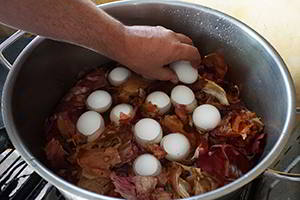 Start by using the parts you normally toss. Toss peelings and other vegetable trimmings into a bag in the freezer. Add these to the pot when making broth.
Start by using the parts you normally toss. Toss peelings and other vegetable trimmings into a bag in the freezer. Add these to the pot when making broth.- Replant root ends of celery, green onions and similar vegetables along with the seeds of fruits and vegetables.
- No garden space? Toss your seeds in an empty, untended lot. Some will grow without any attention.
- Make juice, wine, beer or vinegar from fruit peels and cores. Here is a recipe for making raw apple cider vinegar at home.
- Adopt a use strategy for all leftovers. Use them at following meals, freeze them for an easy lunch, or dehydrate suitable items for shelf stable storage.
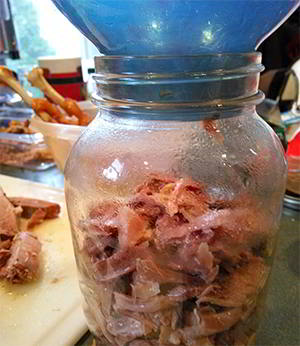 You can even pressure can leftover meats, vegetables, fruits, soups and stews to add to your food storage. Here is a step by step guide with pictures on how to can chicken.
You can even pressure can leftover meats, vegetables, fruits, soups and stews to add to your food storage. Here is a step by step guide with pictures on how to can chicken.- Eggshells are a valuable source of calcium. Add them your compost or dig them into the garden. Feed them to the chickens or clean them and grind them to make a calcium supplement for the family.
- Bones are a good source of phosphorus and calcium. Save them to make bone broth, then dry them and grind them to make bone meal for the garden.
- Coffee grounds and used tea bags are valuable to your compost pile or earthworm bed. You can also add them directly to the garden for acid loving plants.
Meat Fats
- Meat fats are valuable for cooking and seasoning foods. Most everyone is familiar with using bacon fat to season vegetables and meat, but other fats can also be used.
- Duck fat or ham drippings are excellent for roasting potatoes, chicken fat is flavorful used in moderation.
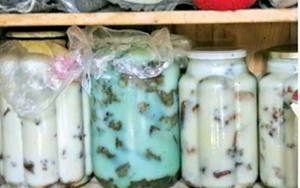 Save the fat trimmings from pork in the freezer to render into lard.
Save the fat trimmings from pork in the freezer to render into lard.- Fats can also be burned in candles or soaked into paper or cardboard for use as a firestarter. Be aware that in a SHTF situation, the smell of bacon from a firestarter or candle might draw unwanted attention.
Related: 5 Ways to Make Survival Candles From Household Items
Drink Bottles
 Plastic soda bottles and other drink bottles are useful containers for long term storage. The first and most important thing to store in empty drink bottles is water. Simply wash the container thoroughly and fill it with water. Cap it, date it and put it away. Empty and refill it yearly, checking for leaks as you go.
Plastic soda bottles and other drink bottles are useful containers for long term storage. The first and most important thing to store in empty drink bottles is water. Simply wash the container thoroughly and fill it with water. Cap it, date it and put it away. Empty and refill it yearly, checking for leaks as you go.- Plastic soda bottles can also be used to store dry goods. Be sure your bottle is clean and completely dry. Fill with rice, corn, grits, beans, small pasta, etc. Add an oxygen absorber for long term storage and seal tightly. Store in a cool, dark place. You can also used them to store ammo.
- Cut off the base and use bottle tops as a mini greenhouse to start seeds outside in the spring, or to make self-watering pots for growing herbs and other container plants.
- Cut a bottle top on the diagonal to make scoops for your buckets of rice, etc.Cut the bottom straight across and use it to start seeds.
Cartons
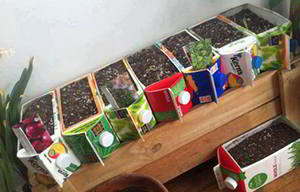 Do you prefer your soda or juice from a can? Hopefully, you already recycle the cans, but those cartons can be useful, too. They are the perfect size for holding cans of vegetables, soups, etc. If you cut a can size opening in the top back, fill from the back and remove cans from the front, they will automatically rotate your supply. Fill each carton with one type of food and stack them for a compact storage solution.
Do you prefer your soda or juice from a can? Hopefully, you already recycle the cans, but those cartons can be useful, too. They are the perfect size for holding cans of vegetables, soups, etc. If you cut a can size opening in the top back, fill from the back and remove cans from the front, they will automatically rotate your supply. Fill each carton with one type of food and stack them for a compact storage solution.- Fill boxes with soil for a short-term container garden or fill with straw for growing potatoes.
Coffee Cans, Yogurt Cups, Jars And Tubs
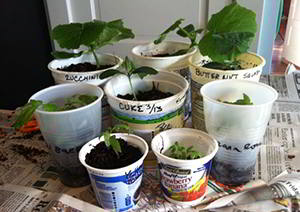 Many of us have a cupboard overflowing with these reusable containers, but we never use them. Use the yogurt cups and tubs to start seeds or store leftovers and dry goods.
Many of us have a cupboard overflowing with these reusable containers, but we never use them. Use the yogurt cups and tubs to start seeds or store leftovers and dry goods.- Jars with sealable lids are good for storing dry goods like cornstarch, baking soda, powdered sugar, and other baking supplies purchased in smaller quantities. Jars offer more protection from humidity and pests than the original box.
- Coffee cans can be used as a growing container for small plants, or for crafts and storage.
Related: How I Grow My Herbs Indoors
Cardboard
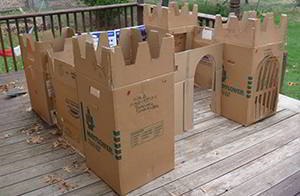 You can save on plastic bags by bringing groceries home in a box, but the box presents a new recycling challenge. If you have young children, you already know that cardboard boxes make many imaginative play toys. Here are a just a few more ideas: open the ends and tape them together to make tunnels, forts and playhouses.
You can save on plastic bags by bringing groceries home in a box, but the box presents a new recycling challenge. If you have young children, you already know that cardboard boxes make many imaginative play toys. Here are a just a few more ideas: open the ends and tape them together to make tunnels, forts and playhouses.- Decorate them to make cars, fire trucks, spaceships and other vehicles.
- Make doll furniture and temporary furniture for small children and pets.
- Use them as a canvas for drawing and painting. Let imaginations run wild.
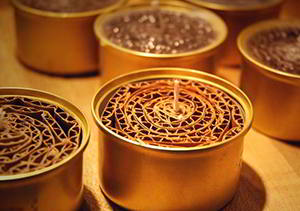 Cardboard burns well, so it is useful as a fire starter or kindling. Tear it into strips and soak it in paraffin wax for excellent charcoal starters and fire starters. This is a good use for cereal boxes, toilet rolls and extra cardboard of all types. Without the wax coating it will burn faster, but is still a useful fire starter.
Cardboard burns well, so it is useful as a fire starter or kindling. Tear it into strips and soak it in paraffin wax for excellent charcoal starters and fire starters. This is a good use for cereal boxes, toilet rolls and extra cardboard of all types. Without the wax coating it will burn faster, but is still a useful fire starter.
Related: How to Make Firebricks (fire logs) and Wood Stove Logs for Free!
Plastic Grocery Bags
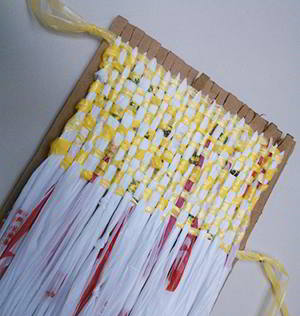 Plastic bags are reusable in many ways. Tie them into knots to make an improvised dish scrubber. Or loop them into a longer loofa. Here are another 21 survival uses for plastic bags.
Plastic bags are reusable in many ways. Tie them into knots to make an improvised dish scrubber. Or loop them into a longer loofa. Here are another 21 survival uses for plastic bags.- Iron plastic grocery bags together on the lowest setting (and use a press cloth) to make a stronger plastic material for making reusable shopping bags or plastic sheeting for any use. Overlap the bags when ironing to make large sheets of any size and thickness. Plastic sheeting made this way can be seen to make many useful items.
- Cut plastic bags into strips and braid into ropes of any size or thickness. Overlap strips to continue braiding until the desired length is reached. Braid thinner ropes together to make thicker, stronger ropes.
Bonus Items To Repurpose
- Old T-shirts: Instead of tossing old T-shirts, consider turning them into practical items like reusable cleaning rags. You can also get creative and upcycle them into a homemade quilt, a tote bag, or even a pillowcase. By doing so, you’re giving new life to worn clothing and reducing waste. It’s an excellent way to reduce, reuse, and recycle while saving money on household items.
-
Old Toothbrushes: Old toothbrushes are perfect for cleaning hard-to-reach areas like grout, around faucets, or small crevices. They can also serve as great tools for arts and crafts projects. For example, use them to create texture when painting, or repurpose them to brush dirt off your shoes or outdoor gear. They’re versatile, functional, and easy to store.
-
Used Coffee Grounds: After your morning cup of coffee, don’t throw away those grounds! They can be used in your garden as a natural fertilizer, providing nitrogen to your soil. Additionally, coffee grounds act as a natural insect repellent, keeping pests away from plants. They’re also great for deodorizing your fridge or even exfoliating your skin when mixed with a bit of oil.
-
Cereal Boxes: Cereal boxes are perfect for a variety of upcycling projects. You can cut them to create seed-starting pots for your garden, or use them to organize your pantry and store smaller items. Their sturdy structure makes them great for DIY crafts and educational projects. With a little creativity, you can turn an ordinary cereal box into a functional household organizer.
-
Plastic Food Containers: Reuse plastic food containers for organizing small items such as screws, nails, or buttons in your garage or craft room. They’re also great for food storage if you’re looking to avoid using single-use plastic bags. Additionally, you can use them as drawer organizers or small bins to store office supplies, making them a valuable item for household organization.
You may also like:
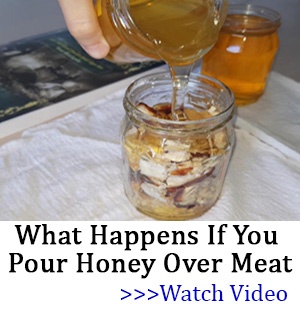 10 Awesome Food Ideas for Your Bug Out Bag
10 Awesome Food Ideas for Your Bug Out Bag
When Grocery Stores Go Empty – A Back Door Shopping Strategy (Video)
How To Make Potato Flakes With 5 Years Shelf Life (without refrigeration)

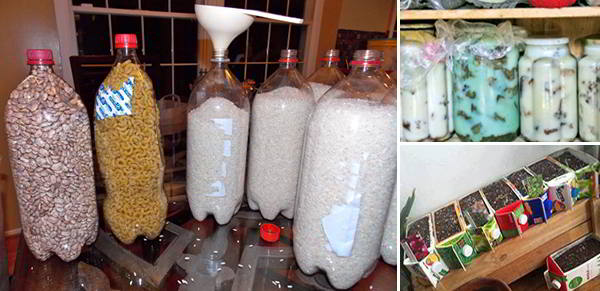













Have you heard about PLANTEGO for bites and stings.
using the leaves as a poultice it stopped the bite of a brown recluse spider.
This is also called plantain, not to be confused with the banana-like fruit. There are over 200 species of this plant. Do they all work the same or only certain ones? (I had to look it up to even know this much.) That’s good to know though if we ever have a brown recluse bit.
All types of plantain works the same. They are even good for salad
Tastes a bit bitter like a kale
A super useful plant
I use fresh out of the garden for all and any bug bites or stings from bees or hornets
Works like a charm just pinch off the leaves and rub it together or chew it up a bit and apply to bite
Also makes a nice slave when boiled down and mixed up with a carrier oil or cream
Other than candle holders or bud vases, does anyone have any ideas for using glass soda bottles or wine bottles? We’re not the artsy-craftsy type so coming up with some use other than stated above has been a challenge. They’re too small to store things like beans or rice. We use 5-gallon buckets for that. We hate to throw away something that can be used. We’re just not sure what else they can be used for or even if they can be used elsewhere. Suggestions?
In the 60’s there was a surge in wine drinking and the usage of bottles after emptying. There was a technique for cutting down the bottles and removing the neck so that the remainder could be used as a drinking cup or other purposes. I made several votive style candles holders out of some of them but soon lost interest and stopped doing it. I think I still have some stored in the garage overhead but am too lazy to climb up there and look for them. As I recall, and remember this is a 50 year old memory, you could use a glass cutter and roll the bottle around its circumference on a flat surface and cut the bottle and then break the bottle along the scratch line much as you would a piece of windows glass. The other method was to tie a string around where you wanted to break the bottle, soak the string with alcohol using an eyedropper, light the string on fire and when it had burned out, dip the bottle in cold water. Once one had removed the top, one then used a coarse whetstone to smooth the edges which were always too sharp to be useful. Be advised, this is strictly from memory that is at least 50 years old.
A more sinister use: According to my in-depth research, conducted at great personal expense and without government subsidy — don’t I wish— wine bottles come in varying thicknesses. The cheaper the wine, the thinner the bottle. The more expensive the wine, the thicker the bottle. Thin bottles shatter easier than thick. If one were to make some sort of inflammatory device to use in defending one’s homestead, thinner bottles would be easier to shatter in order to spread the inflammable contents. So cheap wine bottles could be stored to use in case of emergency.
Also results from an in-depth study, if one buys gallon glass bottles from vendors who sell such for long term water storage, unless you buy in bulk, glass bottles run over $10 a bottle, indeed, as much as $15 a bottle. A discount food store near me sells cheap wine in gallon size glass jugs for less than $10. One can then either drink the cheap wine, pour it out or rebottle it in bottles that once contained much more expensive wine and serve it to friends who don’t mind drinking large quantities of your expensive wine. You will be surprised at how few can tell the difference. Don’t tell the feds that you have rebottled the wine as that is a serious federal felony. Yeah, no kidding. What else is new?
Why glass gallon jugs for water storage? In the event of some sort of water emergency where we are compelled to boil water to use for drinking and personal washing, Once the water has been boiled in a metal container you are going to want to store it in something so that you can get busy boiling more water because unless you have some sort of huge pot that holds a day’s supply of boiled water for the family or however large your group is, you are going to have to get busy boiling some more water. You need something to store the boiled water in. You can’t pour hot water into a plastic soda water bottle or plastic anything, it will melt and there goes the water and the container. Again, unless you have a large supply of metal containers, you are going to want to pour the boiled water in glass jars. Gallon glass jars are the best vessel for that purpose. While you don’t want to pour rapidly boiling water into the jars you won’t have to wait for it to cool as much as you would if you were using plastic. After the water has cooled in the glass jars it can then be transferred to lighter plastic. That’s why glass gallon jugs can be important in your water purification process. Of course, if you are using filters for water purification, you don’t have to worry about hot water, but eventually, if things are bad long enough, you will find there are no more filters available for your Berkey or other great filter. You will be forced to used sand, gravel and charcoal or boil your water in order to purify it.
There is a glass cutter device to cut the tops off bottles and epoxy the top mouth to the bottom of the beverage bottle to make a custom stemmed glass.
I watched a you tube vid on making arrow heads from bottle bottoms. fun hobby, hunting and/or protection piece or a barter item too. No expensive tools required.
What is the video called or can you send a link?
We made our own liquor (fruit, vodka, sugar and water). When it was finished, I repackaged it into wine bottles with cork stoppers. A wax seal is good. I put it in the wine holder and it dripped some and made a mess. Lesson learned. I also use smaller wime bottles to make my own vanilla. A couple of beans covered with vodka. Let it sit and your own vanilla. Good stuff. The colored bottle helps give the vanilla protection from light. And last, you can always fill them with vodka, coffee and a vanilla bean and make your own kahlua. And remember to get a wine box from the liquor store to store your empty bottles in.
The smaller, 16-oz or less, glass soda bottles are useful for drinking water storage. Add a few drops of colloidal silver and it will last far longer than a year. Also, if you have spare, clean glass bottles available, you can buy the larger sizes of fruit juice and pour into the smaller bottles for freezing. Then just take out the bottles as you need them.
I’m ordering a device that cuts glass bottles in half to make a set of drinking glasses. Tops will probably be donated to local artists.
Did you know that you can easily cut glass bottles in half with items that, I can almost guarantee, you have at home?! Rather than spending money on a glass bottle cutting apparatus, try this: take your bottle and decide where you would like the cut to be made. Upon your chosen place, wrap thin yarn around the bottle tightly quite a few times being sure to maintain the placement so its close together and thin. Once you’ve wrapped enough yarn/string, douse it in nail polish remover, or any other extremely flammable liquid, making sure to spin the bottle so all the string is drenched. Next, light it on fire. Spin the bottle as the flame burns to keep it going for as long as possible. Once it goes out, quickly submerge the bottle in ice-cold water. The hot to cold will cause the bottle to break perfectly where you wrapped the string. To make it an acceptable device to drink from, simply sand it down, or the you can use a torch to make it extremely smooth much more quickly.
I use a couple for olive oil with a pour spout available online or at the dollar store.
Forty-plus years ago I used a glass cutter on a longneck bottle of Lone Star and turned the neck into a slide (for guitar playing). It sounded awful, but chicks thought it was cool.
Your post reminded me of a project that I saw on a UK TV show using crushed wine/beer bottles put into an insulated pit in a green house. The heat of the day created a storage heating effect on the chipped glass (plus tubing and an old computer fan) it then released the stored heat and the green house maintained a very good ambient temperature overnight. I am definitely going to try this myself. I think the programme was called “It’s good to be green”
Look it up on Pinterest make glasses out them it’s super easy
Tiki torches!!!! Fill with marbles then wick and tiki oil.
Left over wine bottles can be used to make candles, just fill them with tiki fluid add a wick and a metal lid to hold the wick and use them outside for mosqitos, or even put regular oil n them to use inside as candles. i even decorate mine, I am not a wine drinker so I get mine from friends
I use mine to tincture herbs in alcohol to extract the medicinal compounds.
You can break them up and make mosaic stepping stones with them for a walk way.
You could also see on YouTube how to make bird and squirrel feeders out of these. You could put them in your yard, give as gifts, or sell for profit.
My daughter uses her glass soda, vinegar and wine bottles to put in her walls when they build. It lets in light and is beautiful when the sun hits it. She has also made shorter walks in their patio area.
Gallon glass jugs can be acquired at no cost if one has a glass recycler near by.
But you can’t rely on the label on the glass jug for information regarding what was the last substance stored in the jug. It might say E&J Gallo chablis on the label but it might have contained caustic soda in the interim between the party when the chablis was consumed and the time it showed up at the recycler. If you buy a full bottle of wine, you know what was the last substance in the jug.
I like the gallong jugs from wine we have finished for ourselves. I make my own refills 🙂
Favorite is grandmas dandelion wine or my Cactus juice.
I’ve seen beautiful lamps made from pretty glass bottles. In addition to table lamps, I’ve seen a string of lights made using glass bottles.
You can actually vacuum seal PET bottles for rice, bean,& etc. storage. I made a DIY vacuum chamber back when prepping for Y2K (yep, I’m an old fart). Place a 2 liter bottle of dry beans, with top just barely screwed down to contact bottle neck top surface. Place in heavy PVC ‘chamber’ which is sealed top and bottom with gasketed covers. Once you pull full vacuum on bottle, release chamber vacuum, and twist bottle cap down tight. The vacuum is so powerful that the plastic bottle gets ‘dimples’ in it from the beans inside. If they hold vacuum for a week, you’ll find it will hold for years. I have some that have exceeded 15 years. You can stack the 2 liter bottles of food like cordwood. Just be careful with the top caps. If you bump or bang them, you may lose your seal and the vacuum. Vacuum pumps can be purchased or DIY project from an auto AC compressor pump. Once upon a time there were instructions online. Google is your friend in this case. Good luck & good prepping
I love the concept of upcycling! There’s a company in New Orleans Glass Half Full that collects glass bottles and turns then into sand bags for emergencies and glass jewelry. I love it! I wish there were more companies like this! I recycle everything I can at home.
I used wine and beer bottles to be the edging of a raised garden bed. I have made lamps out of wine bottles. We buy old light weight bundt type cake pans, spray paint them and slide it down on wine bottle necks. We then put the little metal stand that comes in mosquito coils in the cork. We light mosquito coils, put on their little stand on the bottle top. The pretty cake pan catches the ashes.
Number 14 suggests using old, plastic soda bottles to, first and foremost, store water. While I 100% agree with the reduce, re-use, repair, recycle, and – these days – upcycle lifestyle, I think it should be noted that if someone is planning to store ANY liquids in an old soda/pop bottle, they should be sure to store those bottles in a dark and cool area. Major emphasis on these storage details as sunlight heating up those types of plastics ( not all of them, but many of them ) have been proven to cause the plastic to release a chemical that has been directly connected with the cause of certain cancers.